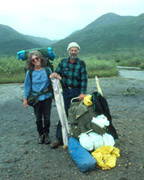Learning to Talk Wolf

Listen–and learn to speak like a wolf
© Bert Gildart: This past week we have been camped in both Yellowstone National Park and West Yellowstone with our friends, Rich, Eleanor and Emma Luhr. As we figured out last night, we have rendezvoused with the Luhrs in many places throughout the United States, beginning in Maine. Other states include Vermont, New Jersey, Florida, Texas, New Mexico, Arizona, Wyoming, and once again, Montana.
At first the common denominator of our friendship was the mutual ownership of our Airstreams, but with time we’ve learned that we share many other interests, such as a love of the outdoors. On several occasions we have day-hiked long distances .
AIRSTREAM LIFE MAGAZINE Rich is the owner-publisher of Airstream Life Magazine , which he produces while traveling on the road. I write for his magazine, usually focusing on national parks. The Luhrs are “Fulltime RVers,” meaning that their RV is their home. Because of their circumstances, they home-school Emma, their seven-year old daughter.
Not all children would respond well to such extensive travel but Emma makes friends everywhere, and she is, of course, exposed to a variety of new experiences, such as hiding food for bears at the Grizzly Wolf Discovery Center.
Yesterday, for instance, while we were out roaming the park, Emma was lifting rocks and logs trying to make it tough for the bears to find food, but as she said, “It didn’t work; they found everything.” Food, of course, is hidden when the bears are in their cages.
The center is an excellent place to learn about nature. Though I focused mostly on bears in my post the other day, the center also educates people about wolves, and if you spend enough time at the wolf compound, you can learn to “Talk Wolf.”
SPEAKING WOLF Wolves are extremely intelligent mammals, but because they don’t do well if taken directly out of the wild, all wolves at the center were born in captivity. Still, they communicate just as their counterparts in the wild.

Bear photography requires long lenses
For starters, they howl and do so for a variety of reasons. They do so to rally the troops before the hunt, to reunite pack members, to tell other packs of their presence and to reinforce social bonds. Likewise, they play for a variety of reasons. Certainly, they play simply for the joy of playing, but they also learn through such interaction about dominance and submission.
Tail position tells part of the story. If it is out straight the wolf is alarmed. If it is between their legs, it feels threatened. Certainly if you own a dog, you’ve seen some of these traits yourself, but in wolves, individuals must know how others in the pack are feeling, for it helps to insure survival. We saw examples of this “language,” in the course of the many hours we spent at their compound.
PHOTO TECHNIQUES Though the wolves at the center are somewhat tolerant of people, it still helps to have long lenses. Though I used an 80 to 400mm lens for several of the photos I took these past few days, the lens I used most was my 600mm, working off a tripod.
The lens is an older manual focus one, but I find that with animal portraits I turn off the auto focus on shorter focal length lenses. With long lenses depth of field is virtually non existent and so you must manually focus on the eye–nothing else will work, and it is virtually impossible to create a tack-sharp eye with auto focus, particularly when there are branches to confuse the sensor. Not only that but generally you must focus on the eye closest too you, otherwise the animal (or person, too, for that matter) will not appear alert and intelligent.
Because the center works at times with the National Park Service, it also provides some information the activities of bears and wolves in the park. It tells about the various Yellowstone packs and today Rich and I will certainly keep our eyes open for wolves, though our goal is to locate a bull and cow moose Janie and I saw yesterday.

Manual focus lenses work best
In Yellowstone, however, you never know what you’ll see. It might be moose, and it might be wolves, and if it is wolves, we’ll know a little more about what they’re saying, for we’ve learned a little about How to Talk Wolf.


October 5th, 2007 at 5:57 pm
Thank you for the wolf article. It was news to me and fascinating. I am so glad to hear Janie is able to go with you. I was worried about her.
May 5th, 2012 at 8:41 am
This organization is a non-profit, and does not make money off of the clsseas it offers. The Institute prices its products to break even, intended just to focus on educating people about why it’s important to protect Yellowstone. Without groups like this, the wolves would not have the protections to remain wild. The association also donates money to support those working on the wolf project in the park.
May 21st, 2012 at 7:17 am
i have 2 wolves and im learning communication and body language and a very easy howl to remember which is to summon the rest of the pack is 2 howls such a row-roooooowwwwwlll